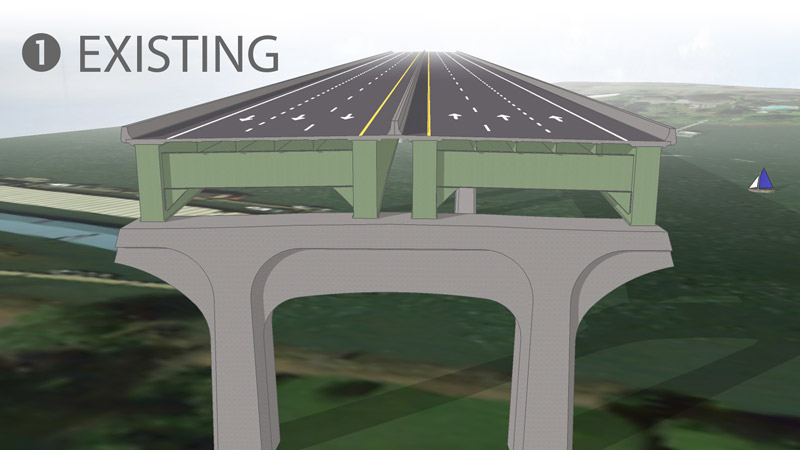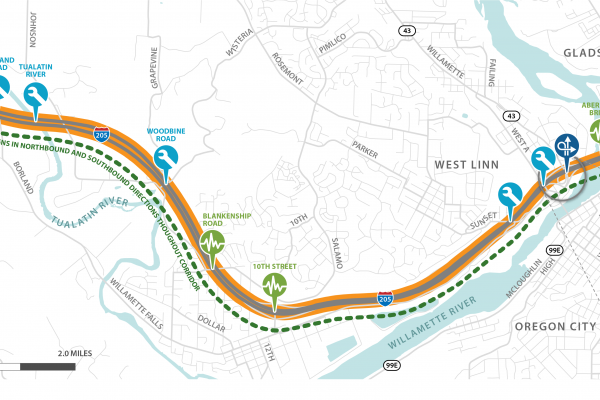Select a station below, or click the buttons at the top of the page to view the stations in order.
Stations
The Issues
- The two-lane section of I-205 between the Abernethy Bridge and the Stafford Road interchange creates a bottleneck that causes congestion and crashes, creating delays for travelers and freight.
- Closely spaced on-ramps on I-205 northbound on the Abernethy Bridge contribute to safety and travel-time predictability issues.
- The Abernethy Bridge and eight bridge sites in the project area are seismically vulnerable in the event of a major earthquake.

Project Benefits
- The addition of a third lane in each direction from Stafford Road to OR 213 helps prevent bottlenecks that cause congestion and crashes, which create delays for travelers and freight.
- Extending the I-205 northbound onramp across the Abernethy Bridge increases safety and travel-time predictability.
- Seismically upgrading the Abernethy Bridge and replacing or retrofitting eight bridge sites in the project area ensures bridges can withstand a major earthquake.
Seismic Lifeline Route
- As a designated Lifeline Route, I-205 is critical to the region for emergency response and economic recovery after a major earthquake.
- This is ODOT’s first project on I-205 to make this route resilient against earthquakes.
- The Abernethy Bridge and eight other bridge sites will be strengthened or replaced to provide seismic resiliency to the corridor.
You can learn more about these solutions on following pages.
 I-205 Widening
I-205 Widening
- The project adds a third lane in each direction on the seven-mile stretch of I-205 between Stafford Road and OR 99E.
- Widening I-205 requires blasting in order to remove the rock from the rock slope located in West Linn on the northbound side of I-205 between the Sunset Avenue overcrossing and just south of the OR 43 interchange. We will conduct additional analyses next year to determine impacts of the blasting, potential mitigations and duration of the work.
 Bridge Replacements
Bridge Replacements
- Widening I-205 requires rebuilding West A Street and Sunset Avenue, which cross over I-205. The Tualatin River, Borland Road, and Woodbine Road bridges will also be replaced.
 Seismic Upgrades
Seismic Upgrades
- The project upgrades the Abernethy Bridge and the eight other I-205 bridges in the project area to withstand a major earthquake. I-205 is designated as a statewide north-south lifeline route, which means it must be operational quickly after a disaster renders other roadways unusable or impassable. This critical route will provide supplies and services to the region.
 Interchange Improvements
Interchange Improvements
In order to improve safety and travel-time predictability on I-205, the project makes changes to on- and off-ramps and intersections around interchanges.
- OR 43 interchange: the project removes the current I-205 northbound on-ramp from OR 43 northbound. Northbound traffic will instead use a new left turn to access the existing on-ramp loop to I-205 northbound. Consolidating these two separate northbound access points eliminates the merging and weaving that currently occurs and reduces rear end crashes. The Broadway Street bridge overcrossing will also be removed. See inset below.
- Analysis is still underway for other intersection improvements at OR 43 and OR 99E. We will present these findings later in the design process.
 Traveler Information Signs (ODOT RealTime)
Traveler Information Signs (ODOT RealTime)
The project includes ODOT RealTime traffic information signs to help travelers get to where they’re going more safely and efficiently. These signs can display traffic flow information, roadway conditions, and advisory speeds limits.
Why a Roundabout?
A roundabout improves safety and operations compared to a signalized intersection. The table below shows traffic control options considered at the northbound I-205 ramp terminal:
| EVALUATION CRITERIA | ROUNDABOUT | SIGNAL |
| Interstate Access* from OR 43 Southbound | ||
| Interstate Access from OR 43 Northbound | ||
| Operations on OR 43 | ||
| Safety | ||
| Access to/from Willamette Falls Drive | ||
| Compatibility with future improvements | ||
| Life-cycle cost savings | ||
|
Ratings: = Positive = Neutral = Negative *Proposed improvements include removal of the existing ramp meter and extension of the auxiliary lane to OR99E exit-ramp. Source: A Safer Choice (FHWA-SA-08-006, a Roundabout Informational Guide) |
||
Morning (AM) Peak Traffic Simulation
Afternoon (PM) Peak Traffic Simulation
Process

1. Construct new bridge foundations and widen to the outside of the existing bridge. Existing lanes will remain open to traffic during this time.

2. Roll existing bridges (in green) approximately 8 feet outward from their existing location during two separate weekend closures.

3. Complete remaining bridge widening toward the center to join the bridges together and remove existing supports. Existing lanes will remain open to traffic.
Blasting Considerations
- Blasting planned during mid-mornings
- Advance notice prior to blast days
- Variable Message Boards on I-5 and I-205 notifying rock blast dates and times
- Overall duration is 7 to 8 months
- Blasts occur approximately every 2 to 3 weeks
- Sounds and vibrations resulting from blasts will not impact surrounding structures
Blasting Process
- Variable Message Boards on I-5 and I-205 indicating rolling slowdown
- Interchange ramps close to traffic
- Pilot cars slow traffic on highway and nearby local streets in advance of blast site
- Blast occurs
- Highway and blast site inspected for safety
- Traffic resumes (20-minute period of total rolling slowdown)


Reducing Noise
If noise levels at a property exceed 65 decibels, the design team will evaluate noise mitigations. Noise walls are the most common tool used to mitigate noise. If noise walls are found to provide adequate benefits based on ODOT and Federal Highway Administration standards, benefited property owners will be able to vote this fall on whether or not to have noise walls constructed. If more than 50 percent of benefited property owners vote in favor of a reasonable noise wall, the wall will be constructed.
What is a decibel?
A decibel is a unit used to measure sound levels. Decibels help us understand and define how loud or quiet something is.
Note: Humans do not usually notice a change in noise of three decibels or less.
Noise Levels (Decibels)

Stay Informed
- Visit the project website: i205corridor.org
- Sign up for the project mailing list.
- For more information about this project, contact:
Ellen Sweeney, ODOT Community Affairs Coordinator
Phone: 503-731-8230 | Email: Ellen.Sweeney@odot.state.or.us
Give us Feedback
Thanks for your interest in the project! Share your project comments or questions below.

















